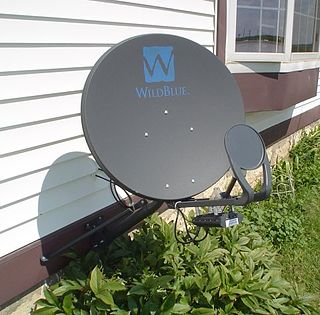THAICOM 4, also known as IPSTAR 1, is a high throughput satellite built by Space Systems/Loral (SS/L) for Thaicom Public Company Limited. It was launched on August 11, 2005, from the European Space Agency's spaceport in French Guiana on board the Ariane rocket. The satellite had a launch mass of 6486 kilograms and is from SS/L's LS-1300 series of spacecraft.
IPSTAR 1 is the world's first High Throughput Satellite [1] capable of providing service to up to two million broadband users or nearly 30 million mobile phone subscribers in the Asia Pacific region. Compared to the one or two gigabit per second (Gbit/s) capacity of a typical satellite designed for Fixed Satellite Services (FSS), IPSTAR was designed to provide broadband Internet service. Its 45 Gbit/s of capacity had never been achieved on a satellite before, enabling IPSTAR to provide up to 6 Mbit/s user download and up to 4 Mbit/s upload speeds for a variety of applications and services.
The satellite's 45 Gbit/s bandwidth capacity, in combination with its platform's ability to provide an immediately available, high-capacity ground network with affordable bandwidth, allows for rapid deployment and flexible service locations within its footprint. The IPSTAR broadband satellite system is composed of a gateway earth station communicating over the satellite to provide broadband packet-switched communications to a large number of small terminals with network star configuration.
A wide-band data link from the gateway to the user terminal employs an Orthogonal Frequency Division Multiplexing (OFDM) with a Time Division Multiplex (TDM) overlay. These forward channels employ highly efficient transmission methods, including Turbo Product Code (TPC) and higher order modulation (L-codes) for increased system performance.
In the terminal-to-gateway direction (or return link), the narrow-band channels employ the same efficient transmission methods. These narrow-band channels operate in different multiple-access modes based on bandwidth-usage behavior, including ALOHA and TDMA for STAR return link waveform.
Traditional satellite technology utilizes a broad single beam to cover entire continents and regions. With the introduction of multiple narrowly focused spot beams and frequency reuse, IPSTAR is capable of maximizing the available frequency for transmissions. Increasing bandwidth by a factor of twenty compared to traditional Ku-band satellites translates into better efficiencies. Despite the higher costs associated with spot beam technology, the overall cost per circuit is considerably lower as compared to shaped beam technology.
IPSTAR's Dynamic Power Allocation optimizes the use of power among beams and allocates a power reserve of 20 percent to be allocated to beams that may be affected by rain fade, thus maintaining the link.
Telecommunications in Tuvalu cover Tuvalu's 6 atolls and 3 reef islands. The islands of Tuvalu rely on satellite dishes for communication and internet access.
Network throughput refers to the rate of message delivery over a communication channel, such as Ethernet or packet radio, in a communication network. The data that these messages contain may be delivered over physical or logical links, or through network nodes. Throughput is usually measured in bits per second, and sometimes in data packets per second or data packets per time slot.
Digital subscriber line is a family of technologies that are used to transmit digital data over telephone lines. In telecommunications marketing, the term DSL is widely understood to mean asymmetric digital subscriber line (ADSL), the most commonly installed DSL technology, for Internet access.

In telecommunications, frequency-division multiplexing (FDM) is a technique by which the total bandwidth available in a communication medium is divided into a series of non-overlapping frequency bands, each of which is used to carry a separate signal. This allows a single transmission medium such as a microwave radio link, cable or optical fiber to be shared by multiple independent signals. Another use is to carry separate serial bits or segments of a higher rate signal in parallel.

In telecommunications, broadband or high speed is the wide-bandwidth data transmission that exploits signals at a wide spread of frequencies or several different simultaneous frequencies, and is used in fast Internet access. The transmission medium can be coaxial cable, optical fiber, wireless Internet (radio), twisted pair cable, or satellite.
Data Over Cable Service Interface Specification (DOCSIS) is an international telecommunications standard that permits the addition of high-bandwidth data transfer to an existing cable television (CATV) system. It is used by many cable television operators to provide cable Internet access over their existing hybrid fiber-coaxial (HFC) infrastructure.

Internet access is a facility or service that provides connectivity for a computer, a computer network, or other network device to the Internet, and for individuals or organizations to access or use applications such as email and the World Wide Web. Internet access is offered for sale by an international hierarchy of Internet service providers (ISPs) using various networking technologies. At the retail level, many organizations, including municipal entities, also provide cost-free access to the general public.
4G is the fourth generation of broadband cellular network technology, succeeding 3G and preceding 5G. A 4G system must provide capabilities defined by ITU in IMT Advanced. Potential and current applications include amended mobile web access, IP telephony, gaming services, high-definition mobile TV, video conferencing, and 3D television.

Satellite Internet access is Internet access provided through communication satellites; if it can sustain high speeds, it is termed satellite broadband. Modern consumer grade satellite Internet service is typically provided to individual users through geostationary satellites that can offer relatively high data speeds, with newer satellites using the Ku band to achieve downstream data speeds up to 506 Mbit/s. In addition, new satellite internet constellations are being developed in low-earth orbit to enable low-latency internet access from space.

Evolution-Data Optimized is a telecommunications standard for the wireless transmission of data through radio signals, typically for broadband Internet access. EV-DO is an evolution of the CDMA2000 (IS-2000) standard which supports high data rates and can be deployed alongside a wireless carrier's voice services. It uses advanced multiplexing techniques including code-division multiple access (CDMA) as well as time-division multiplexing (TDM) to maximize throughput. It is a part of the CDMA2000 family of standards and has been adopted by many mobile phone service providers around the world particularly those previously employing CDMA networks. It is also used on the Globalstar satellite phone network.

A passive optical network (PON) is a fiber-optic telecommunications technology for delivering broadband network access to end-customers. Its architecture implements a point-to-multipoint topology in which a single optical fiber serves multiple endpoints by using unpowered (passive) fiber optic splitters to divide the fiber bandwidth among the endpoints. Passive optical networks are often referred to as the last mile between an Internet service provider (ISP) and its customers. Many fiber ISPs prefer this technology.
Regenerative Satellite Mesh – A (RSM-A) is an internationally standardized satellite communications protocol by Telecommunications Industry Association and European Telecommunications Standards Institute.

E-UTRA is the air interface of 3rd Generation Partnership Project (3GPP) Long Term Evolution (LTE) upgrade path for mobile networks. It is an acronym for Evolved UMTS Terrestrial Radio Access, also known as the Evolved Universal Terrestrial Radio Access in early drafts of the 3GPP LTE specification. E-UTRAN is the combination of E-UTRA, user equipment (UE), and a Node B.

Inmarsat is a British satellite telecommunications company, offering global mobile services. It provides telephone and data services to users worldwide, via portable or mobile terminals which communicate with ground stations through fifteen geostationary telecommunications satellites.

High Speed Packet Access (HSPA) is an amalgamation of two mobile protocols—High Speed Downlink Packet Access (HSDPA) and High Speed Uplink Packet Access (HSUPA)—that extends and improves the performance of existing 3G mobile telecommunication networks using the WCDMA protocols. A further-improved 3GPP standard called Evolved High Speed Packet Access was released late in 2008, with subsequent worldwide adoption beginning in 2010. The newer standard allows bit rates to reach as high as 337 Mbit/s in the downlink and 34 Mbit/s in the uplink; however, these speeds are rarely achieved in practice.
International Mobile Telecommunications-Advanced are the requirements issued by the ITU Radiocommunication Sector (ITU-R) of the International Telecommunication Union (ITU) in 2008 for what is marketed as 4G mobile phone and Internet access service.

O3b is a satellite constellation in Medium Earth orbit (MEO) owned and operated by SES, and designed to provide low-latency broadband connectivity to remote locations for mobile network operators and internet service providers, maritime, aviation, and government and defence. It is often referred to as O3b MEO to distinguish these satellites from SES's forthcoming O3b mPOWER constellation.

Tooway is a satellite broadband Internet service available across Europe. The first version of the service was launched in 2007 via two Eutelsat geostationary satellites, Hot Bird 6 and Eurobird 3, respectively at the 13° and 33° East orbital positions.

KA-SAT is a high-throughput geostationary telecommunications satellite owned by Viasat. The satellite provides bidirectional broadband Internet access services across Europe and a small area of the Middle East, and additionally the Saorsat TV service to Ireland. It is positioned at 9°E, joining the Eurobird 9A Ku band satellite. KA-SAT was manufactured by EADS Astrium, based on the Eurostar E3000 platform, with a total weight of 6 tons. It was launched by Proton in December 2010. The satellite is named after the Ka band frequency, which is used on the spacecraft.
High-throughput satellite (HTS) is a communications satellite that provides more throughput than a classic FSS satellite for the same amount of allocated orbital spectrum, thus significantly reducing cost-per-bit. ViaSat-1 and EchoStar XVII do provide more than 100 Gbit/s of capacity, which is more than 100 times the capacity offered by a conventional FSS satellite. When it was launched in October 2011 ViaSat-1 had more capacity (140 Gbit/s) than all other commercial communications satellites over North America combined.